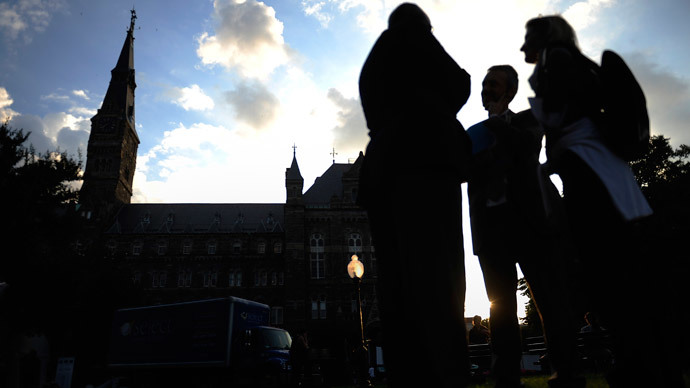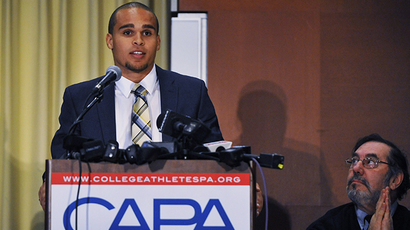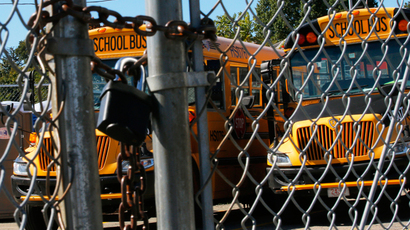Student loan debts top $1 trln in US

The student loan industry is booming, saddling over 37 million college students and graduates with $1.08 trillion in loans in 2013, even as President Barack Obama and lawmakers work to rein in the crippling debt young people face in the US.
The average cost of a Bachelor’s degree at a private college or university is $45,000, according to The College Board’s Trends in Higher Education. Students attending public schools in their home state pay just under $23,000 on average, while those paying out-of-state tuition can expect to pay more than $36,000 a year. In 2012, The College Board says the average student carried over $6,000 student loans for the academic year.
Of the nearly 20 million Americans who attend college each year, about 12 million borrow, according to the Almanac of Higher Education. Estimates show that the average four-year graduate accumulates $26,000 to $29,000 in loans, and some leave college with debt totaling in the six figures. Those students who continue on to graduate school, especially law and medical school, see their debt balloon.
All that debt hits as soon as students graduate, whether they have a job or not. And millennials - those born after 1982 - were the hardest hit group in the Great Recession, as professionals with experience took entry-level jobs just to get by and millennials sometimes took unpaid internships after graduation, in the hopes that the experience would translate into a job. In 2012, the unemployment rate for college graduates under the age of 24 was 9.4 percent, while the overall unemployment rate hovered around 8 percent, according to the Bureau of Labor and Statistics. Those who didn’t get a job or an unpaid internship turned to graduate school, adding to their overall debt.
Now college graduates are realizing they may have mortgaged their future to pay for their educations as interest piles on to the initial loan. A brief based on the Federal Reserve Board’s Survey of Consumer Finances and other sources, shows that, over a lifetime of employment and saving, $53,000 in education debt leads to a wealth loss of nearly $208,000.
Nida Degesys, who graduated in 2013 from Northeast Ohio Medical University with about $180,000 in loans, told the Associated Press, "There were times where this would make me stay up at night." With interest, Degesys now owes a total of $220,000. "The principal alone is a problem, but the interest is staggering."
But these same graduates also have a much higher earning potential than those who don’t receive a Bachelor’s degree. According to the Pew Research Center, millennials aged 25-32 with a four-year degree earn an average of $45,500 a year, compared with $30,000 for those with an associate’s degree or some college and $28,000 for someone with only a high school education. They also have a lower unemployment rate: 3.8 percent versus 8.1 percent or 12.2 percent, respectively.
That higher earning potential doesn’t help them down the line, though. Gregory Zbylut pays $1,300 a month towards his $160,000 in law school loans. He graduated from Loyola University in Chicago in 2005. He estimates he could have saved $150,000 to $200,000 if that monthly payment had gone into a 401(k) retirement account instead. He’s been turned down twice for a mortgage, he told AP, and he’s been unable to marry his fiancé between his debts and her son. "I have more education and more degrees than my father, as does she than her parents, and yet our parents are better off than we are. What's wrong with this picture?" he said.
The government is stuck between a rock and a hard place when it comes to fixing the student debt crisis. The federal government funded 43 percent of student loans in the 2012-2013 academic year, The College Board said. Borrowers are locked into a 6.8 percent interest rate for student loans, while the average interest rate for a 30-year, fixed-rate mortgage is much lower at 4.5 percent. The Congressional Budget Office estimates the “break even” interest rate for the student loan program would be around 2.5 percent. The CBO also projects the government will earn $184 billion off student loans over the next ten years. But that profit comes on the backs of the government’s constituents, and student loans (unlike all other types of loans) don’t go away in bankruptcy or after death.
Sen. Elizabeth Warren (D-Mass.) is leading the charge to change the way the federal government loans money to students. “I'd like us to go a long way toward letting people deal with student loans the same way they deal with home mortgages and medical debts,” she told the Huffington Post in September. Warren plans to introduce legislation that would allow borrowers to refinance their debts the way that homeowners and businesses can already refinance.
“This exploding debt is also dragging down our economy. With monthly loan bills that can easily exceed a mortgage payment, it’s no surprise that homeownership among thirty-year olds has declined steeply. And last spring, the Federal Reserve raised concerns that rising student debt may threaten our overall economic growth,” Warren wrote in prepared remarks for a speech on the Senate floor. Warren’s plan would also focus on bringing down the costs of higher education. She would pay for the lost revenue by enacting the so-called “Buffett Rule” to close tax loopholes on millionaires.
On Thursday, at a Senate Health, Education, Labor and Pensions (HELP) Committee hearing, Sen. Tom Harkin (D-Iowa) proposed limiting the amount of money graduate students can borrow and reducing the loan amounts for certain categories of undergraduate students. Before 2006, graduate students could only borrow up to $138,500 total in federal loans and also had an annual cap on the amount they could borrow.
Congress lowered the interest rate on some student loans to 3.86 percent for the 2012-2013 academic school year, but that only affects current borrowers who receive the federal unsubsidized loans.














